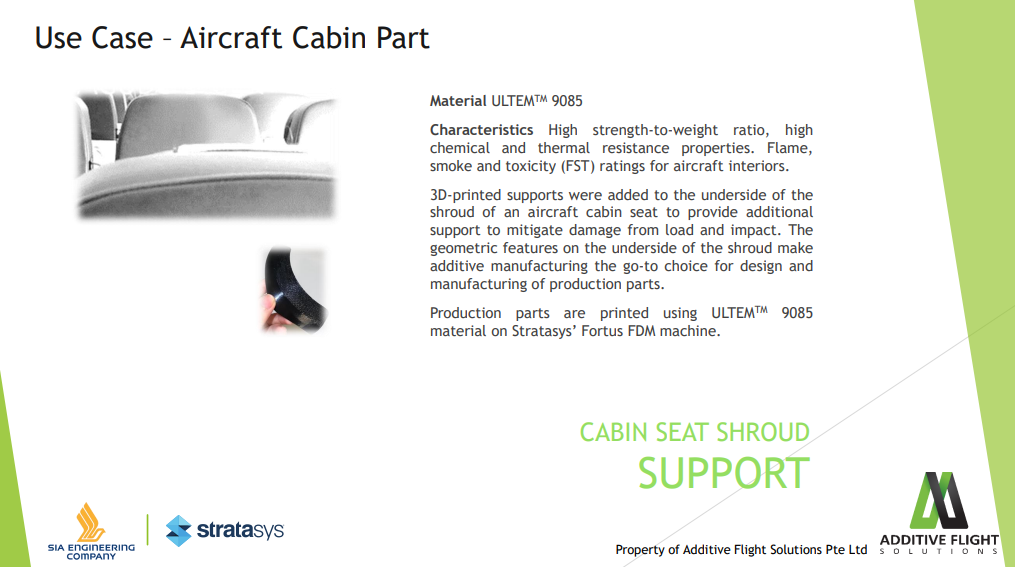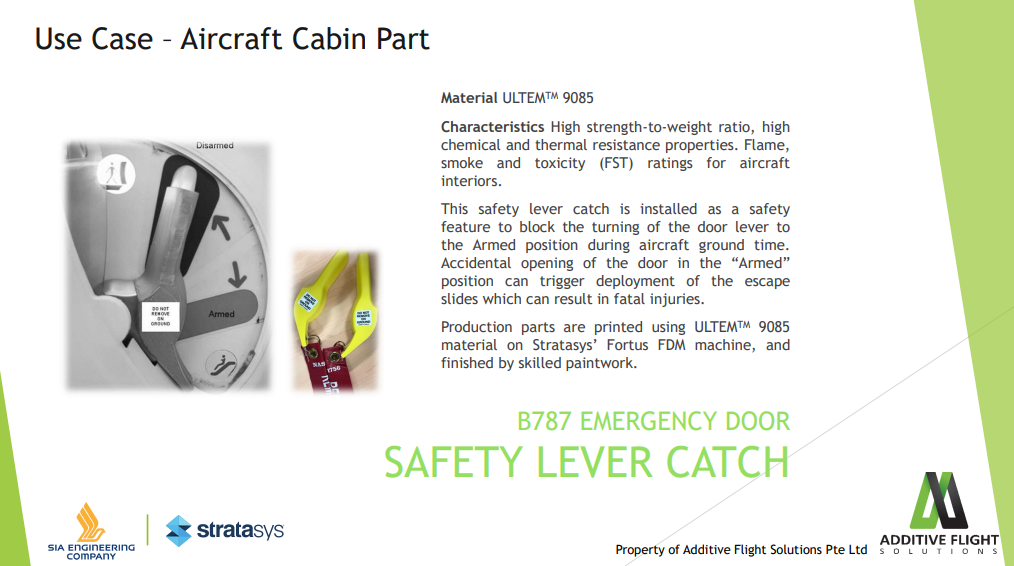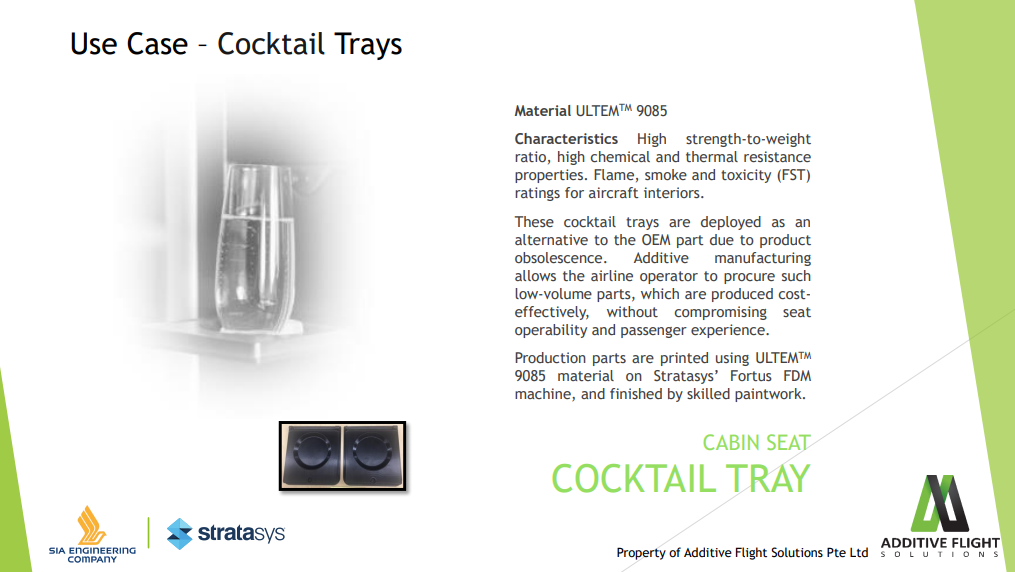In the wee hours of the morning of July 2, I attended the last segment of the Stratasys Aerospace Webinar Series, “Value Proposition of AM to Airlines,” enjoying a presentation by Chuan Ching Tan, General Manager for Additive Flight Solutions (AFS) in Singapore.
The focus remained on parts that can be 3D printed for aircraft, business models to be offered to the airlines, use cases for aircraft cabins via AFS, and what obstacles must be overcome to drive adoption. The development of parts was engineered through a joint venture consisting of Stratasys, SIA Engineering Company, and AFS.
Tan began by explaining that in forming the joint venture in 2018, all involved came to the table with a vision for AM as a key technology for the partners to provide solutions to the airlines. And considering they have used FDM 3D printing technology to produce over 5,000 certified parts for aircraft cabins now, their work has gone far beyond the conceptual stage to true reality—with functional parts being used in commercial aircraft cabins.
The first aircraft cabin part highlighted by Tan was a cover meant to protect seat controllers, preventing passengers from accidentally pushing the buttons and activating movement. Because the controllers were so sensitive, this had become a need especially as “do not disturb” buttons could be pushed too easily, leading to misunderstandings while in flight. The required design for the cover was suitable for AM processes rather than another more traditional technique like injection molding.
Tan explained that this is where “the sweet spot” comes in for the business model, offering a solution to airlines that is more affordable, allows for faster production of a low volume order (less than one thousand covers, most likely), as well as easier replacement of parts and maintenance. They were also able to produce another cover, meant for controlling the seat—preventing them from being activated when baggage pressed against them, or passengers hit them with their knees.
The part was printed on a Stratasys Fortus 3D printer using ULTEM 9085.
The next part highlighted included 3D printed supports for the underside of the passenger seat, meant to prevent damage due to wear and tear—and load and impact due to ongoing use. Aircraft seats tend to be lightweight due to weight requirements for planes, but this can result in a lack of necessary strength, too.
Another interesting 3D printed part was fabricated in response to the need for an improved clip to hold back aircraft curtains which were coming loose too often. There are seven different designs for these covers/curtains, meaning that the team was required to 3D print an array of curtain rail end covers.
“That is where production becomes interesting, because you are looking at so many different customized designs, yet they are not big in volume,” explained Tan, who continued to relay again that these types of needs are where 3D printing proves itself as a good solution for applications like aerospace and aircraft interiors.
Next, Tan presented the 3D printed safety level catch they created for the emergency doors of the Boeing 787. This is a critical part meant to ensure that the emergency doors do not open while the aircraft is on the ground, creating the potential for injuries and even death as escape slides could be accidentally triggered.
Other products created were a 3D printed cocktail tray (probably to be phased out in the next few years, thus presenting the perfect opportunity to use affordable 3D printing in low-batch volume), and holders for bathroom soap and sanitizer dispensers.
Hurdles are still present, however, because 3D printing does not “make the cut” for all solutions in terms of aircraft cabin replacement parts; still, Tan pointed out that there are numerous “sweet spots” in terms of gaining opportunities to offer solutions to the airlines. Tan understands the reality and necessity for use of other technologies and materials at times too, but also envisions accelerated use of AM processes in airline applications.
While engineers have been using 3D printing and additive manufacturing for aerospace applications for decades now (think NASA), airline companies have made headlines for numerous endeavors with digital fabrication, to include other accoutrements for in-flight cocktails, in-flight catering, and other interior components.
Subscribe to Our Email Newsletter
Stay up-to-date on all the latest news from the 3D printing industry and receive information and offers from third party vendors.
You May Also Like
3D Printing Webinar and Event Roundup: April 28, 2024
In this week’s 3D Printing Webinar and Event Roundup, the Ceramics Expo is taking place in Michigan, Stratasys continues its advanced training courses, and SPE is holding a Polymer Characterization...
Initial Speakers and Sponsors Announced for Additive Manufacturing Strategies 2025
Nearly a year away from the event, the Additive Manufacturing Strategies (AMS) 2025 conference is already beginning to take shape. Building upon the success of 2024’s summit, AMS has established...
HP & INDO-MIM Collaborate to Boost Metal 3D Printing in India
HP Inc. and INDO-MIM, a US- and India-based supplier of metal injection molding (MIM) powders and contract manufacturer, have announced that the two companies will collaborate to accelerate additive manufacturing...
One of US’s Largest Machine Tool Resellers to Offer Stratasys 3D Printing
In a key move for the additive manufacturing (AM) stalwart, Stratasys (Nasdaq: SSYS) has announced a strategic partnership with Select Additive Technologies, a division of Morris Group, Inc., which is...








































